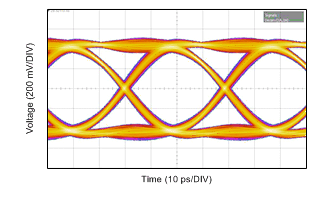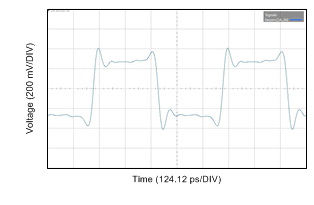SNLS561B February 2017 – October 2019 DS250DF210
PRODUCTION DATA.
- 1 Features
- 2 Applications
- 3 Description
- 4 Revision History
- 5 Description (continued)
- 6 Pin Configuration and Functions
-
7 Specifications
- 7.1 Absolute Maximum Ratings
- 7.2 ESD Ratings
- 7.3 Recommended Operating Conditions
- 7.4 Thermal Information
- 7.5 Electrical Characteristics
- 7.6 Timing Requirements, Retimer Jitter Specifications
- 7.7 Timing Requirements, Retimer Specifications
- 7.8 Timing Requirements, Recommended Calibration Clock Specifications
- 7.9 Recommended SMBus Switching Characteristics (Slave Mode)
- 7.10 Recommended SMBus Switching Characteristics (Master Mode)
- 7.11 Typical Characteristics
-
8 Detailed Description
- 8.1 Overview
- 8.2 Functional Block Diagram
- 8.3
Feature Description
- 8.3.1 Device Data Path Operation
- 8.3.2 Signal Detect
- 8.3.3 Continuous Time Linear Equalizer (CTLE)
- 8.3.4 Variable Gain Amplifier (VGA)
- 8.3.5 Cross-Point Switch
- 8.3.6 Decision Feedback Equalizer (DFE)
- 8.3.7 Clock and Data Recovery (CDR)
- 8.3.8 Calibration Clock
- 8.3.9 Differential Driver With FIR Filter
- 8.3.10 Debug Features
- 8.3.11 Interrupt Signals
- 8.4 Device Functional Modes
- 8.5 Programming
- 8.6 Register Maps
- 9 Application and Implementation
- 10Power Supply Recommendations
- 11Layout
- 12Device and Documentation Support
- 13Mechanical, Packaging, and Orderable Information
Package Options
Mechanical Data (Package|Pins)
- ABM|101
Thermal pad, mechanical data (Package|Pins)
Orderable Information
9.2.6 Application Curves
Figure 22 shows a typical output eye diagram for the DS250DF210 operating at 25.78125 Gbps with PRBS9 pattern using FIR main-cursor of +18, precursor of –1 and postcursor of +2. All other device settings are left at default.
Figure 23 shows an example of DS250DF210 FIR transmit equalization while operating at 25.78125 Gbps. In this example, the Tx FIR filter main-cursor is set to +15, postcursor to –3 and precursor to –3. An 8T pattern is used to evaluate the FIR filter, which consists of 0xFF00. All other device settings are left at default.
 Figure 22. DS250DF210 Operating at 25.78125 Gbps
Figure 22. DS250DF210 Operating at 25.78125 Gbps  Figure 23. DS250DF210 FIR Transmit Equalization While Operating at 25.78125 Gbps
Figure 23. DS250DF210 FIR Transmit Equalization While Operating at 25.78125 Gbps